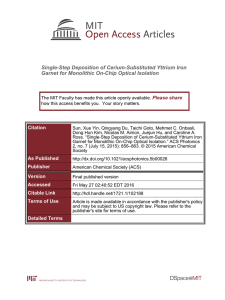Academic and Research Staff
advertisement
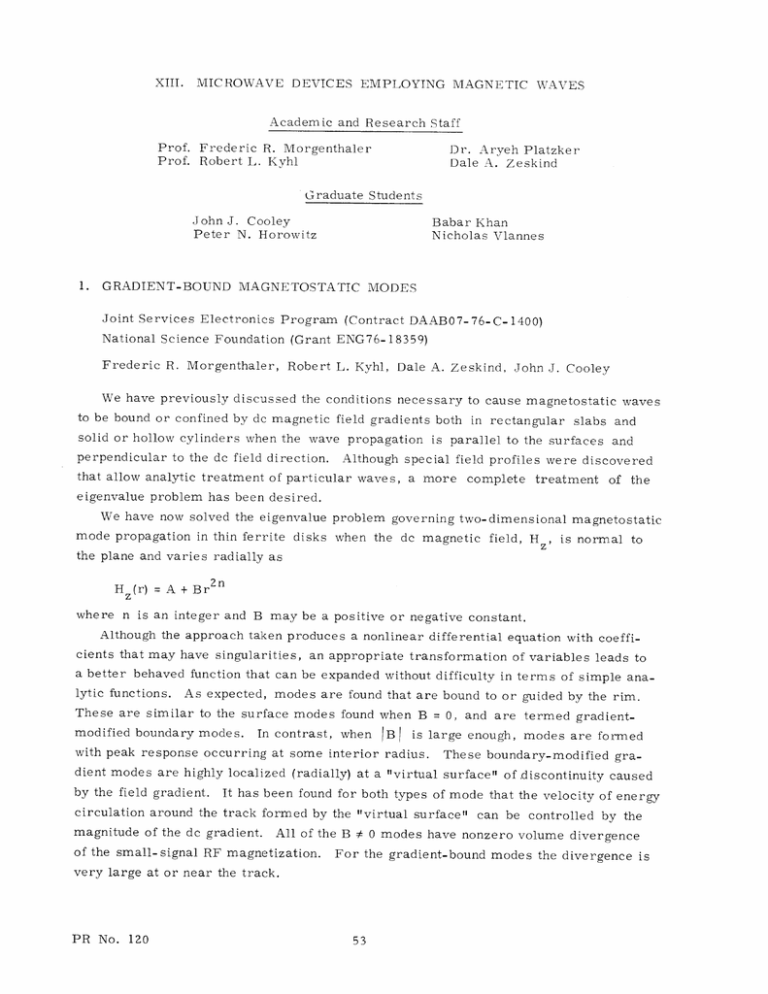
XIII. MICROWAVE DEVICES EMPLOYING MAGNETIC WAVES Academic and Research Staff Prof. Frederic R. Morgenthaler Prof. Robert L. Kyhl Dr. Aryeh Platzker Dale A. Zeskind Graduate Students John J. Cooley Peter N. Horowitz 1. GRADIENT-BOUND Babar Khan Nicholas Vlannes MAGNETOSTATIC MODES Joint Services Electronics Program (Contract DAAB07-76-C-1400) National Science Foundation (Grant ENG76-18359) Frederic R. Morgenthaler, Robert L. Kyhl, Dale A. Zeskind, John J. Cooley We have previously discussed the conditions necessary to cause magnetostatic waves to be bound or confined by de magnetic field gradients both in rectangular slabs and solid or hollow cylinders when the wave propagation is parallel to the surfaces and perpendicular to the de field direction. Although special field profiles were discovered that allow analytic treatment of particular waves, a more complete treatment of the eigenvalue problem has been desired. We have now solved the eigenvalue problem governing two-dimensional magnetostatic mode propagation in thin ferrite disks when the de magnetic field, Hz, is normal to the plane and varies radially as Hz(r) = A + Br2n where n is an integer and B may be a positive or negative constant. Although the approach taken produces a nonlinear differential equation with coefficients that may have singularities, an appropriate transformation of variables leads to a better behaved function that can be expanded without difficulty in terms of simple analytic functions. As expected, modes are found that are bound to or guided by the rim. These are similar to the surface modes found when B = 0, and are termed gradientmodified boundary modes. In contrast, when BI is large enough, modes are formed with peak response occurring at some interior radius. These boundary-modified gradient modes are highly localized (radially) at a "virtual surface" of discontinuity caused by the field gradient. It has been found for both types of mode that the velocity of energy circulation around the track formed by the "virtual surface" can be controlled by the magnitude of the de gradient. All of the B : 0 modes have nonzero volume divergence of the small-signal RF magnetization. For the gradient-bound modes the divergence is very large at or near the track. PR No. 120 (XIII. MICROWAVE DEVICES EMPLOYING MAGNETIC WAVES) The effects of metallic boundaries placed in proximity to the ferrimagnetic disks have also been considered in the calculations. With simple modification, the theory is also applicable to disks transformed to annular rings by removal of their centers. Experiments have been conducted on uniformly magnetized thin films of yttrium iron 3) garnet (YIG) grown on substrates of gadolinium gallium garnet (G by LPE techniques. Several such films approximately 5 microns in thickness have been very kindly supplied to us by Dr. Howard Glass of Rockwell International. They were grown under their Contract F44620-75-C-0045 with the Air Force Office of Scientific Research. High-Q magnetic resonances have been observed in our preliminary experiments on 2n field prothese films, and magnetic pole pieces designed to generate the A + Br files are under construction. An attempt will be made to study the gradient-bound modes by means of optical scattering techniques. The highly localized RF energy is expected to enhance such optical interactions. John J. Cooley completed his study of bound modes in thick single YIG disks and on September 12, 1977 submitted a thesis entitled "Magnetostatic Modes Bound by de H-Field Gradients" in partial fulfillment of the requirements for the degrees of Master of Science and Electrical Engineer. A summary of his thesis follows. The study of high-Q microwave modes bound to an intentionally nonuniform de magnetic field in a single crystal of yttrium iron garnet (YIG) was reported. The modes of a YIG disk, magnetized perpendicularly to its plane, and with internal de field profiles either concave or convex were excited locally by fine-wire antenna structures. Modes 3 with loaded Q's on the order of 10 varied linearly with the externally applied bias field at a rate of 2. 8 MHz/Oe over the frequency range 2. O0to 18. 0 GHz. The internal field profiles resulted from placing the disk in either an initially uniform magnetic field (in which case the field was monotonic with the maximum at the disk edge), or a nonuniform external field shaped by high permeability magnetic pole pieces (to approximate a para- bolic internal field with the maximum at the center of the disk). The crystal used had dimensions of 1. 97 mm (radius) and 0. 33 mm (thickness), was cut along the (110) plane, and had both plane faces polished to optical standards. Excitation was achieved via two separate coupling structures: one in which the YIG acted as a resonant absorber and one in which the YIG coupled two nominally uncoupled antennas. Experimental results for the uniform external field configuration showed that two types of modes exist. There are well-coupled modes (10-20 dB insertion loss) which occur in a multiplet pattern (singlet, doublet, triplet, etc.) and there are poorly coupled modes (30-40 dB insertion loss) which do not follow this pattern. Experimental results for the shaped external field configuration do not show clearly defined multiplets. Subject to the simplifying assumptions that the variation of the dc and HF fields in the direction perpendicular to the plane of the disk may be ignored, a formalism for PR No. 120 (XIII. MICROWAVE DEVICES EMPLOYING MAGNETIC WAVES) finding the eigenmodes of a general circularly symmetric internal field profile was discussed and a computer algorithm implemented. are The computer-generated eigenmodes -directed and bound to circular tracks of constant radii. Families of eigenfrequen- cies which vary linearly with applied dc magnetic field at the rate of 2. 9 MHz/Oe exhibit multiple degeneracies which suggests the possibility of multiplets. The widths of the experimentally observed mode spectra (approximately 1. 5-2. 0 GHz) agree qualitatively with computer- generated mode spectra. 2. MAGNETOSTATIC SURFACE WAVES CONTROLLED BY AN ADJUSTABLE AIR GAP Joint Services Electronics Program (Contract DAABO7-76-C-1400) Frederic R. Morgenthaler, Peter N. Horowitz, Dale A. Zeskind The S.M. thesis of Peter N. Horowitz is progressing and concerns the control of magnetostatic surface wave group velocity on a sandwich structure composed of two ferrite rectangular slab crystals separated by an adjustable air gap. This geometry, sug- gested by Tsutsumi, appears to be a valuable one in which to study fundamental wave properties and material constants. Both theoretical and experimental work involving mode localization by means of high magnetic flux concentration will also be conducted with special attention given to thin film geometries. 3. MAGNETOELASTIC YIG DELAY LINES Joint Services Electronics Program (Contract DAAB07-76-C-1400) Frederic R. Morgenthaler, Aryeh Platzker The conventional magnetoelastic delay line employs input and output couplers located at the same end of a cylindrical YIG single crystal. Improved electromagnetic input/output isolation would result from moving input and output to opposite ends of the crystal, but this requires operating with two "turning points" and two spin-elastic "crossover" surfaces. As our first attempt at producing such a structure, we have synthesized an on-axis magnetic field profile that is approximately vee-shaped, with two regions of constant gradient having opposite signs. Preliminary experiments have revealed unexpected properties and cast new light on high power saturation effects caused by too large focusing of the magnetostatic spin-wave beam. A major study aimed at finding optimum focusing conditions is under way. PR No. 120
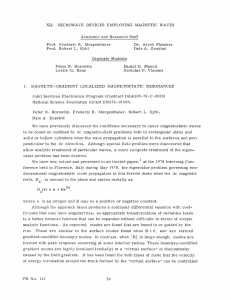




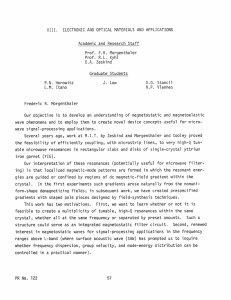



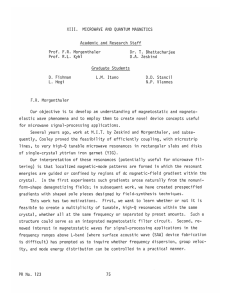
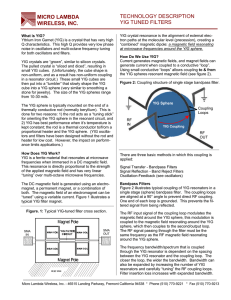
![Enhanced Magneto-optic Kerr Effect and Magnetic Properties of CeY[subscript 2]Fe[subscript 5]O[subscript](http://s2.studylib.net/store/data/012563754_1-ae55aebfe1a61a1bed2880161d4667cb-300x300.png)
